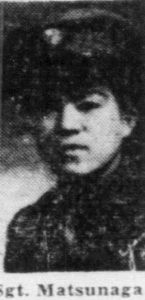Raymond Park, age 22, from Hawaii.
Service era: Korea
Date of death: Thursday, November 2, 1950
Death details: During the last week of October 1950, Republic of Korea (ROK) Army forces under the control of the U.S. Eighth Army were advancing deep in North Korean territory, approaching the Yalu River on the Chinese-Korean border. Chinese Communist Forces (CCF) struck back in a surprise attack, engaging the ROK 1st and 6th Divisions near Unsan, some sixty miles north of Pyongyang. The U.S. 1st Cavalry Division, with the 8th Cavalry Regiment in the lead, was rushed forward to reinforce the ROK units in the Unsan area. On November 1, the regiment’s 1st Battalion took up positions north of Unsan, while the 2nd Battalion moved to guard the Nammyon River valley west of town, and the 3rd Battalion was placed in reserve at the valley’s southern end. Sergeant Raymond Park joined the U.S. Army from Hawaii and was a member of Company E of the 2nd Battalion, 8th Cavalry Regiment, 1st Cavalry Division. On November 2, 1950, Company E was in defensive positions with the 2nd Battalion near Unsan when it came under heavy attacks and was forced to withdraw. Many soldiers, including SGT Park, took to the surrounding hills to escape. On November 5, these soldiers encountered a group of CCF, who then fired upon them. Sergeant Park was killed in the encounter. Several repatriated American prisoners of war (POWs) confirmed this report; however, a burial location was not recorded. Additionally, SGT Park has not been identified among the remains returned to U.S. custody after the ceasefire. Today, Sergeant Park is memorialized on the Courts of the Missing at the National Memorial Cemetery of the Pacific.
Source: National Archives, Defense POW/MIA Accounting Agency
